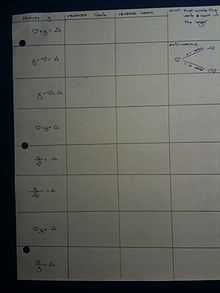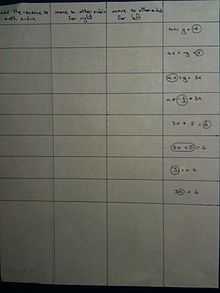KinderCalculus/peel
< KinderCalculusPeel
Often, we are given an equation, say 4x + 5y = 3, and be asked to "solve for y". An equation can be thought of in many ways:
- conceptually, it is like a scale that must keep the balance on both sides of "=".
- syntactically, peeling layers off one side of the equation and putting it on the other side can be thought as peeling a layer of clothing off. One must start from the outer most layer of the equation or clothing and work inwards. "solve for y" means peeling the layers off y to leave it as a bare & naked "y = ...". In other words, we "nudify" y. (These terms are meant to be comical and innocent, not meant to be risque. Below are alternative analogies for teachers who prefer something else.)
In peeling, one must take care to avoid the "blunderwear" pitfall: reaching pass the outer layers to peel & reverse inner layers. For example, in solving for y
2 + y x + 3
----- = ----- incorrectly becomes
5 7
y x + 3
- = ----- - 2, an outbound blunderwear, or
5 7
5*x + 3
2 + y = -------, an inbound blunderwear
7
Problems with the Standard Notation
From the point of view of a 2nd or 3rd grader, the basic notations of + - * / are confusing" due to the
- non-commutivity of - and /
- the equivalence of a verb and its double negative x-4 vs x+-4, 4x vs x/(1/4)
- the dual context of "-" & "/" as verb and adjectives (negative & reciprocal)
- inconsistent placement of + & *, eg. ( x * 1/5 ) vs ( x/5 ), ( x + -5 ) vs ( x - 5 )
For example, when asked to solve for x in 4 = x + 5 the result sometimes becomes
4 - 5 = x, or on paper when there's not enough room between the characters "4" and "="
-5 4 = x, or
4 + 5 - = x
The child's focus is in getting the 2 characters "5" and "-" there, and not in their position. In the 1st expression "-" is a verb and in the 2nd it's an adjective. It's not obvious to the child why the 2nd is wrong -- it has the exact same characters as the correct answer and the child was taught that minus is the same as plus negative, and that plus is commutative.
Another point of confusion comes from nested fractions in solving for y below
1 2 2 1 1
- = - --> 1 = - y --> --- = y this nested fraction is often confused for -
y x x 2 2
- ---
x x
and the child's answer becomes
1 x
- instead of -
2x 2
The child has difficulty perceiving the layering here. Here is another unnecessary bit of complexity resulting from the notation. The same mechanics of a double inverse is at play here that occurs in double negative, but because the notation of multiplicative inverse 1/x is much different from that of -x, connecting these 2 ideas confuses a child.
Though reverse verbs have cleaner notation, they break the commutative symmetries of their forward origins and causes the confusion above. All in all, it's best to avoid the thorny convenience of reverse verbs and stick with forward verbs when peeling a layer. Alternatively, one can use the cleaner Dot Notation below.
The Forward-Reverse Equivalence (freq)
This pitfall comes from the asymmetries of the Standard Notation. Consider the 3 possibilities (a,b,c) below in solving for y in x = y + z
+---+-------+
(a) | | (b) |
v v |
|
... x = y + z
or
y + z = x
| ^
| | (c)
+------+
- Position (b) requires the child to erase and rewrite "x" to squeeze "z" in place. The unforgiving nature of paper and cognitive load of erasing can be distracting during learning difficult concepts.
- Position (c) requires rewriting to reflect across "=", again imposing a cognitive load.
- Position (a) requires the answer "-z + x" instead of "x - z". On top of the difficult lesson of Peel & Reverse, the child must also master the reverse-forward equivalence.
This mastery requires work because a child must distinguish the correct form from the 7 possibilities of flanking x:
- z + - x
- z - + x
- -z + - x
- -z - + x
- -z + x
- x + - z
- x - z
One cannot simply tell the child that last forms are correct but also explain why the others are wrong. Additionally, if there are other terms at "...", the child must copy the equation to a new line or erase and rewrite the expression, mentally leaving space for the "z". This is additional cognitive load.
We have a similar situation with the equivalence of divide and its forward verb version. It is this difficulty that Dot Notation is designed to avert.
Dot Notation
We propose a radical alternative notation to sidestep this confusion of standard notation.
- replace adjectives with dots
- abolish anti-verbs in favor of anti-nouns
- make verbs invisible
Actually, this change is not too radical in that the 2nd and 3rd rules are already part of the standard notation for + * ^, though it is only used half the time. The dot notation uses these rules consistently.
This practice makes all +-*/ verbs commutative -- very easy for students. Because this notation changes the basic way that expressions are written I do not hold any hopes that it will be adopted, but it does avoid the confusions above and would be a good hypothetical exercise. Here are examples of the notation (due to typographical challenges, "*" will represent a dot). Placement of the dot and noun juxtapositions will be as follows: horizontal for times & reciprocal, and vertical for plus & negative.
| Standard Notation | -4 | x+4 | x-4 | 1/4 | 4*x | x/4 | Quadratic formula (+ version) |
| Dot Notation |
*4 |
x 4 |
*4 x |
* 4 |
4x |
* 4 x |
*b
| *
| 2
+--+---+
| *4ac | *
| +-------- 2 a
| 2 |
| b |
+------+
The position of the
adjective "*" between 2
nouns indicates that its
scope spans both nouns.
Also, the closer the nouns are to
each other, the deeper the layer
is inwards, ie. the higher the
order of precedence.
|
We could also apply the dot notation to exponentials, log, and roots. However, the anti-verbs log and root does not translate into commutative forward verbs so we gain less in using dots here. Note that in the Dot notation x-4 and x+-4 are written the same way up to commutivity. Similarly for x/4 and x*1/4. Now, the problem with solving linear equation above disappears.
The rule for peeling becomes: as an element moves across the "=" side,
take the anti-noun and keep the vertical/horizontal juxtaposition
4 = x + 5
rewrites in dot notation as
5
4 = x
moving 5 to the other side yields
* 4
5
= x or x = *
4 5
there's no possibility of error by mistaken context or commutivity
Pitfalls
one common peeling mistake is to reverse too many things at the same time.
For examle,
10x + |_| = /_\
|_| = /_\ - x/10
or
|_| = /_\ +
Exercises


